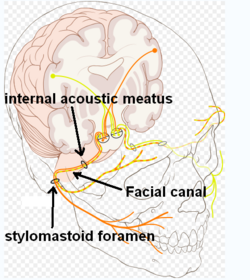|
Facial canal
The facial canal (also known as the Fallopian canal) is a Z-shaped canal in the temporal bone of the skull. It extends between the internal acoustic meatus and stylomastoid foramen. It transmits the facial nerve (CN VII) (after which it is named). AnatomyThe facial canal gives passage to the facial nerve (CN VII) (hence the name).[1][verification needed][better source needed] Its proximal opening is at the internal auditory meatus; its distal opening is the stylomastoid foramen. In humans, the canal is approximately 3 cm long, making it the longest bony canal of a nerve in the human body.[2][verification needed][better source needed] It is located within the middle ear region.[verification needed][better source needed] The facial nerve gives rise to three nerves while passing through the canal: the greater petrosal nerve, nerve to stapedius, and the chorda tympani.[3] StructureHorizontal partThe proximal portion of the facial canal is termed the horizontal part. It commences at the introitus of facial canal at the distal end of the internal auditory meatus. The horizontal part is further subdivided into two crura: the proximal/medial[4] anteriolaterally[5] directed medial crus (or labyrinthine segment[5]), and the distal/lateral[4] posteriolaterally[5] directed lateral crus (or tympanic segment[5]); the two crura meet at a sharp angle at the genu of facial canal (geniculum canalis facialis[6]) where the geniculate ganglion is situated (at the genu, the greater petrosal nerve leaves the facial canal through the hiatus of the facial canal).[4] Descending partThe lateral crus of horizontal part ends by turning sharply inferior-ward, commencing the distal-most descending part (or mastoid segment[5]) of facial canal which passes vertically inferior-ward, ending distally at the stylomastoid foramen. The descending part presents two openings through each of which a branch of the facial nerve passes: the nerve to stapedius enters the canaliculus for nerve to stapedius, and the chorda tympani enters the posterior canaliculus of chorda tympani (canaliculus chordae tympani, or iter chordae posterius[7]).[8] RelationsThe labyrinthine segment is situated superior to cochlea.[5] The canal traverses the medial wall of the tympanic cavity superior to the oval window;[citation needed] here, the prominence of the facial canal (or prominence of the aqueduct of Fallopius) upon the medial wall indicates the position of the superior portion of the facial canal.[9]: 745 The canal then curves nearly vertically inferior-ward along the posterior wall.[citation needed] The tympanic segment is closely related to the posterior and medial walls of the tympanic cavity; it passes superior to the oval window and inferior to the lateral semicircular canal.[5] Clinical significanceThe facial canal may be interrupted in some people. This may lead to the facial nerve being split into 2 or 3 fibres, or it may be poorly formed or congenitally absent on one side.[2] HistoryThe facial canal was first described by Gabriele Falloppio.[10] This is why it may also be known as the Fallopian canal.[10] Gallery
See alsoReferences
|
||||||||||||||||||||||||




